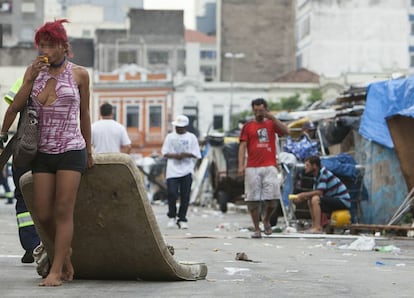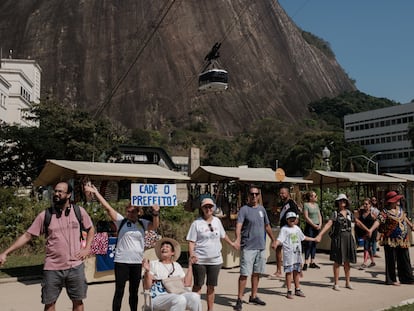Homelessness in Brazil has increased tenfold in a decade to more than 200,000 people
President Lula announced a $200 million plan to provide them with social assistance, although only 150 housing units are expected to be built

The landscape in the centers of large Brazilian cities is quite eloquent: hundreds of people sheltered under arcades, viaducts or bridges, plastic and cardboard camps in the most central squares and, in some cases, extreme pockets of misery and drug addiction, such as the infamous Crackland in downtown São Paulo, a handful of streets dominated by crack addicts. The problem of homelessness in Brazil is obvious and not new, but data shows that it has worsened enormously in recent years. The number of homeless people increased tenfold in a decade, from nearly 22,000 in 2013 to more than 227,000 this year, according to figures from the country’s Institute of Applied Economic Research (Ipea). To deal with this problem, the government of Luiz Inácio Lula da Silva presented on Monday a plan endowed with 982 million reais ($200 million). The project will be more centered on providing assistance to the homeless population, rather than to reintegrating them into society or tackling the circumstances that left them homeless to begin with.
Half of the budget announced by President Lula will be dedicated to food, reinforcing the allocation to states and municipalities, which run shelters and soup kitchens. In addition, 5,000 health professionals will be trained to work on the streets and a health policy will be created exclusively for the homeless.
Almost half (47.3%) of homeless Brazilians ended up on the street due to family issues or problems with romantic partners. Unemployment (40.5%), alcohol and drug addiction (30.4%) and loss of housing (26.1%) are some of the other reasons. The average age is 41 years, the majority are men, and the study also shows that, as is almost always the case, racial differences go hand in hand with inequality: while 56% of the Brazilian population is Black, 69% of homeless Brazilians are Black. The authors of the study conclude that the increase in homelessness can be explained by economic stagnation — Brazil has not been growing strongly for almost a decade — and by the effects of the Covid-19 pandemic.
Ipea warns that the 227,000 figure is probably not accurate, as many homeless people tend to hide their condition because of the social stigma attached to living on the streets, and, in the case of women, for fear of losing custody of their children.
An important part of the resources included in Lula’s plan will go to campaigns against aporophobia (discrimination against homeless people), the creation of support points such as bathrooms or laundries, shelters for the LGBTQ+ community, literacy courses, and programs for the regularization of documents. So-called hostile architecture is also prohibited, that is, the use of materials or structures intended to prevent homeless people from sleeping in certain public places.
The housing policy, which at first glance would seem to be central to addressing the problem, is, of the seven axes of the plan, the fifth with the smallest budget. The housing pillar will receive 3.7 million reais ($750,000), with which it intends to include the homeless in public housing social programs and build 150 homes throughout Brazil, “with priority for families with children and pregnant women.” The section earmarked for training courses, promotion of cooperatives and associations and insertion in the labor market has an even smaller allocation of 1.2 million reais ($243,000).
The rise in homelessness coincides with a time in which large cities, such as São Paulo, Rio de Janeiro, Belo Horizonte or Recife, are implementing urban development plans to attract residents to the most centric neighborhoods, which were previously left abandoned. Millionaire incentives and tax exemptions are being given to construction companies to encourage the rehabilitation of historic buildings in these city centers and convert them into residential buildings. Developers are also being encouraged to build new housing complexes. In general, most of these development plans don’t mention the creation of public housing for the poorest residents. Nor is the homeless population taken into account, many of which congregate in these city centers.
Unifying the intentions of the federal government and that of states and municipalities is another major challenge. The previous national homeless policy had been in place since 2009, but only five states and 15 cities implemented it in recent years.
The new program devised in Brasília by the Ministry of Human Rights has a strong welfare character that may not be entirely in line with the wishes of the municipal authorities. Recently, in Rio, Mayor Eduardo Paes — an ally of Lula — was embroiled in controversy after he proposed a mechanism that would allow drug addicts who refuse to go to shelters to be forcibly removed from the street for treatment. In July of this year, the Supreme Court accepted an appeal by leftist parties and social movements and prohibited the forced removal and transportation of homeless people, as well as the confiscation of their property.
Sign up for our weekly newsletter to get more English-language news coverage from EL PAÍS USA Edition
Tu suscripción se está usando en otro dispositivo
¿Quieres añadir otro usuario a tu suscripción?
Si continúas leyendo en este dispositivo, no se podrá leer en el otro.
FlechaTu suscripción se está usando en otro dispositivo y solo puedes acceder a EL PAÍS desde un dispositivo a la vez.
Si quieres compartir tu cuenta, cambia tu suscripción a la modalidad Premium, así podrás añadir otro usuario. Cada uno accederá con su propia cuenta de email, lo que os permitirá personalizar vuestra experiencia en EL PAÍS.
¿Tienes una suscripción de empresa? Accede aquí para contratar más cuentas.
En el caso de no saber quién está usando tu cuenta, te recomendamos cambiar tu contraseña aquí.
Si decides continuar compartiendo tu cuenta, este mensaje se mostrará en tu dispositivo y en el de la otra persona que está usando tu cuenta de forma indefinida, afectando a tu experiencia de lectura. Puedes consultar aquí los términos y condiciones de la suscripción digital.
More information
Archived In
Últimas noticias
Most viewed
- David King, chemist: ‘There are scientists studying how to cool the planet; nobody should stop these experiments from happening’
- Reinhard Genzel, Nobel laureate in physics: ‘One-minute videos will never give you the truth’
- Mexico completes its trade shift with the entry into force of tariffs on China and countries without trade agreements
- Oona Chaplin: ‘I told James Cameron that I was living in a treehouse and starting a permaculture project with a friend’
- Sinaloa Cartel war is taking its toll on Los Chapitos










































